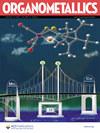Arene Insertion into the M–Cl Bond vs Addition-like Behavior of Arene and M–Cl Bond (M = Cu/Fe): A DFT Investigation of the Cu/Fe SET Mechanism of Arene sp2 C–H Chlorination
IF 2.5
3区 化学
Q2 CHEMISTRY, INORGANIC & NUCLEAR
Organometallics
Pub Date : 2025-03-27
DOI:10.1021/acs.organomet.4c0048910.1021/acs.organomet.4c00489
引用次数: 0
Abstract
MClx-catalyzed (MClx = CuCl2/FeCl3) arene sp2 C–H chlorination was calculated at the DKH//B3LYP-D3//DKH-def2-TZVP level in solvent. The mechanism consists of two competing paths: (i) the arene insertion path into the M–Cl bond and (ii) the M–Cl addition-like path onto the arene ring. The latter path has fewer steps and lower activation energies. In both paths, one M–Cl bond breaks at the first step and then the valence state stays at Cu(I)/Fe(II) for the main part of the following steps. Cu exhibits better catalytic performance due to its lesser bonding capability. Weak M–H interactions were observed in the insertion mechanism.

芳烃插入M - cl键与芳烃和M - cl键的类加成行为(M = Cu/Fe):芳烃sp2 C-H氯化反应Cu/Fe SET机理的DFT研究
在溶剂中以DKH//B3LYP-D3//DKH-def2- tzvp水平计算MClx催化(MClx = CuCl2/FeCl3)芳烃sp2 C-H氯化反应。该机制包括两个相互竞争的路径:(i)芳烃插入M-Cl键的路径和(ii)芳烃环上的M-Cl加成路径。后一种途径的步骤更少,活化能更低。在这两种路径中,一个M-Cl键在第一步断裂,然后在接下来的步骤中,价态保持在Cu(I)/Fe(II)。铜由于其较弱的键合能力而表现出较好的催化性能。在插入机制中观察到弱的M-H相互作用。
本文章由计算机程序翻译,如有差异,请以英文原文为准。
求助全文
约1分钟内获得全文
求助全文
来源期刊

Organometallics
化学-无机化学与核化学
CiteScore
5.60
自引率
7.10%
发文量
382
审稿时长
1.7 months
期刊介绍:
Organometallics is the flagship journal of organometallic chemistry and records progress in one of the most active fields of science, bridging organic and inorganic chemistry. The journal publishes Articles, Communications, Reviews, and Tutorials (instructional overviews) that depict research on the synthesis, structure, bonding, chemical reactivity, and reaction mechanisms for a variety of applications, including catalyst design and catalytic processes; main-group, transition-metal, and lanthanide and actinide metal chemistry; synthetic aspects of polymer science and materials science; and bioorganometallic chemistry.
 求助内容:
求助内容: 应助结果提醒方式:
应助结果提醒方式:


